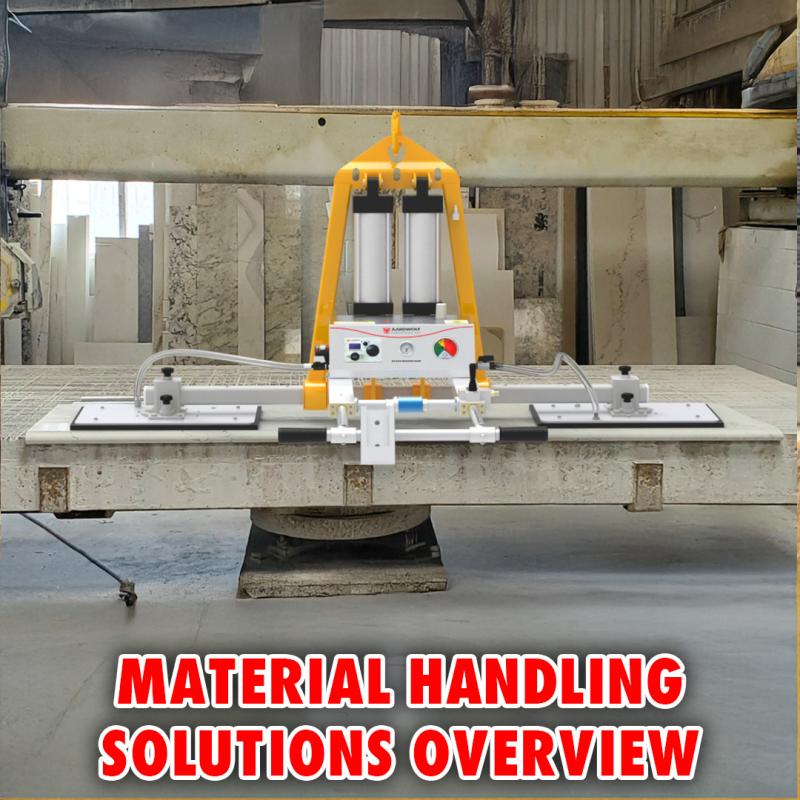



From manual tasks to fully automated workflows, a robust material handling strategy not only safeguards products and personnel but also drives productivity, cuts costs, and enhances competitiveness in the material handling industry. In this comprehensive guide, we explore why automation matters, the essential types of material handling equipment, and best practices for shop-floor design.
Material handling encompasses every action taken to move components, products, and raw materials within industrial environments. Whether it’s loading freight into a truck, transporting slabs through a fabrication facility, or storing finished goods in a warehouse, material handling integrates people, processes, and machinery to:
Reduce inventory levels and shrinkage
Increase throughput and on-time delivery
Standardise workflows and quality control
Lower labour costs and minimise injuries
Protect valuable or hazardous cargo
By optimising material handling systems, manufacturers and distributors can meet customer demands more rapidly while maintaining strict safety and compliance standards.
Automated conveyors, robotic pick-and-place arms, and autonomous guided vehicles (AGVs) significantly accelerate operations by handling repetitive lifting and transport tasks. Advanced material handling systems deliver consistent performance with minimal downtime, allowing businesses to scale output without a proportional increase in labour.
Manual lifting and manual handling tasks are a leading cause of workplace injuries. By introducing overhead cranes, automated hoists, and mechanised lifts, companies can reassign personnel to value-added roles and dramatically lower the incidence of musculoskeletal disorders.
Seamless integration of semi-automated and fully automated equipment—such as sorting conveyors, palletisers, and labeling stations—minimises bottlenecks. Integration with warehouse management systems (WMS) ensures real-time inventory visibility, enabling just-in-time replenishment and tighter coordination across the supply chain.
Implementing ergonomic designs, protective guarding, and task-specific machinery reduces manual handling risk. Regulatory frameworks—like the HSA Safety, Health and Welfare at Work Regulations—mandate risk assessments and the use of mechanical aids wherever feasible. Adhering to these standards safeguards employees and shields companies from costly liabilities.
Although the initial investment in automated advanced material handling systems can be substantial, businesses often recoup costs within months through reduced labour expenses, lower damage rates, and higher throughput.
Modular solutions—from conveyors to lift tables—allow companies to adapt their workflows to changing product lines or seasonal demand. Equipment like horizontal scissor systems and slab lifting systems can be reconfigured or relocated with minimal downtime.
A well-rounded material handling strategy leverages a mix of manual, semi-automated, and fully automated equipment:
Gravitational conveyors: Energy-free movement of cartons or totes via gravity.
Roller and belt conveyors: Powered transfer for consistent flow.
Accumulation conveyors: Buffer stock between workstations to regulate throughput.
Overhead cranes: Ideal for moving heavy or bulky loads across large spans, an integral component of gantry crane material handling. Equipment choices include single-girder and double-girder models, optimised for load capacity and span.
Industrial jib cranes: Floor- or wall-mounted units provide localized lifting support—perfect for assembly stations and maintenance bays. Explore our industrial jib cranes for flexible, cost-effective lifting solutions.
Scissor lifter: Versatile for elevating pallets or workpieces to ergonomic heights.
Clamp lifters: Combine with lifting clamps for secure handling of irregular shapes.
Horizontal scissor systems: Large-format tables that raise heavy materials safely and smoothly.
Electric vacuum lifter slab lifters enable single-operator handling of stone, glass, and metal panels. These electric vacuum lifter systems drastically reduce manual strain and accelerate slab throughput.
Securing loads for transport is critical. Our ratchet straps and ratchet tie down traps deliver exceptional load retention and comply with tightening torque requirements to prevent slippage or shifting.
From beam clamps to plate clamps, lifting clamps provide a rigid, non-slip grip on steel, wood, and composite materials. They integrate seamlessly with hoists, cranes, and gantry systems to enhance load control.
A strategically laid-out shop floor minimises unnecessary movement. Position material-handling equipment—conveyors, workstations, storage racks—in a U-shaped or straight-line flow to reduce travel distances and eliminate cross-traffic.
Hybrid cells, blending automated handling with human oversight, deliver both flexibility and precision. For example, robotic pick-and-place arms can feed parts to an operator who performs quality checks—combining the strength of machines with human judgment.
Selecting reputable material-handling companies ensures access to tailored solutions, rapid support, and end-to-end project management—from layout design to commissioning.
Collaborative robots (cobots) and AGVs are reshaping the material handling landscape. These solutions automate repetitive lifts and transports, freeing workers for higher-value tasks.
Sensor-equipped forklifts and real-time location systems (RTLS) provide granular visibility into inventory location and asset utilisation. Predictive maintenance analytics reduce unplanned downtime.
Next-generation drives, regenerative braking, and solar-assisted warehouses lower carbon footprints. Efficient systems also translate to lower operating expenses.
Implementing or upgrading a material handling program begins with a thorough needs analysis:
Assess current workflows: Map material flow and identify bottlenecks.
Conduct risk assessments: Determine manual handling hazards and compliance gaps.
Define performance targets: Set KPIs for throughput, safety incidents, and return on investment.
Engage stakeholders: Involve floor operators, maintenance teams, and management to ensure buy-in.
Pilot and scale: Test solutions—such as conveyor segments, clamp lifters, or cobot cells—before full-scale roll-out.
Working with experienced integrators and selecting the right mix of equipment—from conveyors and gantries to scissor lifts and vacuum lifters—will generate measurable gains in productivity, safety, and profitability.
Effective material handling is more than just moving goods; it’s about orchestrating people, processes, and technology to create a safe, agile, and cost-efficient operation. By leveraging the right combination of material handling equipment, automation, and strategic layout, manufacturers and warehouses can meet the evolving demands of the market while safeguarding their most valuable assets—employees and products.
For tailored guidance on upgrading your facility, connect with our team of specialists or explore the latest in advanced material handling systems.
Sign up to receive the latest info on new Aardwolf products, special offers and more.
By signing up you agree to receive emails from Aardwolf with news, special offers, promotions and other information. You can unsubscribe at any time.